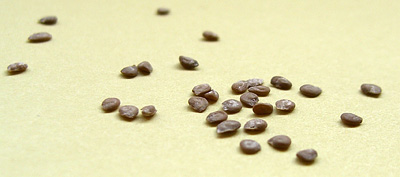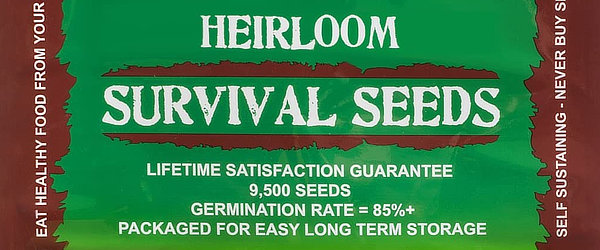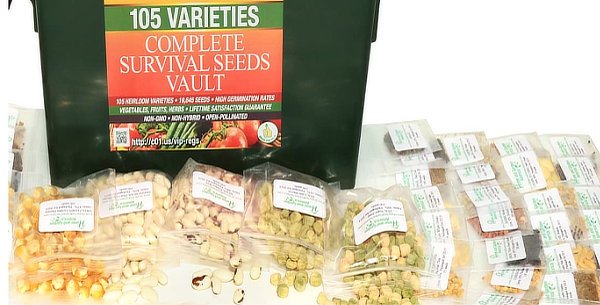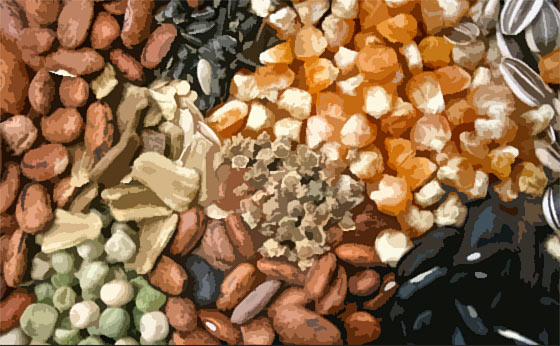Survival Seeds For Preparedness – Things To Consider
When looking for long term survival seeds, you should consider calories, carbohydrates, protein, nutrition, and those easier to harvest without machinery.
Survival Seeds – Vegetable Calories
We need foods which provide the caloric energy to keep us going!
When looking at the yield of calories per pound, some of the vegetables that come out on top are…
Dry beans such as Pinto or Navy beans (require long warm summers) are very high in calories (~ 570 calories /lb.). However ordinary green beans only contain about 140 calories /lb.
Yams contain more calories than ordinary potatoes (~ 460 calories /lb.) however yams grow best in hot climates.
- Potatoes (~ 340 calories /lb.)
- Corn (~ 340 calories /lb.)
- Peas (~ 330 calories /lb.)
- Parsnip (~ 280 calories /lb.)
- Acorn squash (~ 220 calories /lb.)
- Beets (~ 180 calories /lb.)
[ Read: Garden Vegetable Calories ]
Grains, starchy vegetables and fruit all provide calories.
Corn grown as a grain is a good ‘survival’ choice. Although it does require a lot of comparative square footage for those calories. Not only is corn very high in carbohydrates, it yields better than the small grains like wheat. Corn can also be grown and harvested with simple hand tools.
“Potatoes, sweet corn, & beans. Yes, its the backbone of my garden and the sweet thing about it is, all the seeds can be saved for next year..”
~ commenter here on MSB
Survival Seeds – Carbohydrates
Starchy vegetables include root crops.
Starchy vegetables, as the name implies, contain starch and sugar. Much like a grain, they provide energy and can sustain life. Starches are complex carbohydrates that produce vital energy when your body converts them to glucose during digestion.
Examples include carrots, parsnip, potato, pumpkin, rutabaga, turnip, beets, winter squash.
Fruit tastes sweet because of the sugar, but is not as high in carbohydrates as it seems. Small fruits like berries and grapes can be established in a few years, but trees will take much longer. If you have a place to plant them, do it THIS year.
Vegetables High In Protein
As most of us know, meat is the highest protein source. However, did you know that dried pumpkin seeds have extraordinarily high protein content? Nearly as much, pound for pound, as meat! So, when you grow those pumpkins, harvest the seeds too!
As we go down the list of vegetables, those a bit higher in protein than others include soy beans, beans (black, pinto, kidney), and peas.
[ Read: The Amount of Protein You Need ]
The Most Nutritional Vegetables
Macronutrients and Micronutrients. Some vegetables are much more nutritious than others. When considering survival seeds, you should very much consider these too!
The list of extra nutritional vegetables include spinach, swiss chard, cauliflower, asparagus, carrots, broccoli, onions & garlic, kale, beets, bell peppers, green peas, and collard greens.
“Glad you brought up Kale! Kale is TOPS for a home-grown, nutrient dense vegetable. With all of the uses of Kale and Kale seeds, I consider Kale to be the most important ‘green’ crop available in my area.”
“Also, even though vitamins and minerals will be only a small concern in a worst case scenario, I find that Kale produces a TON of nutrient dense greens from a small space.”
~ comments here on the blog
[ Read: Broccoli – I Grow The Plant For Its Antioxidant Health Benefits ]
Survival Seeds
With that said, many of us have some sort of extra storage of seeds. Personally, I keep most of mine in an old plastic ammo box. It contains quite a mixture of seeds I’ve purchased during the last several years, as well as those I’ve saved from my plantings.
Heirloom Seeds versus Hybrid Seeds

Heirloom seeds will produce plants that are the same, year after year. They have the same genetic make up as the parent plant they came from. All generations will produce the same fruit or vegetable and have the same taste that you remember from your grandparents garden plants. An heirloom plant is one that has been passed down through generations.
The seeds that are withheld and dried from a heirloom tomato for example, will again produce the same wonderful tomato plant the next growing season. It is a self sustaining food producing system.
The downside is that heirloom seeds and their subsequent plants will typically require more care and prevention from pests and disease since they have not been altered for disease and/or climate tolerance. However it is best to learn how to garden with them if you are at all concerned about self sustained living.
Hybrid seeds and the plants that grow from them have been bred for various qualities including disease resistance and production yield. As diseases evolve to attack the newer hybrids, the hybrid itself is re-engineered to combat the evolving threat. Hybrids are also engineered for specific climates and environments.
The produce of Hybrid plants will produce seeds, however, the results of the follow-on planting may not be so successful. The use of hybrids require that you buy new seeds, year after year. This is not self sustaining. However an advantage is disease tolerance and other inbred tolerances which will better assure results.
“As a gardener with 40 years experience, I recommend you have a mix of heirloom and hybrid seeds.”
“Heirlooms because they breed true, and hybrids for hybrid vigor.”
~ commenter on MSB
Survival Seeds. They provide peace of mind.
Of course the key is ‘know-how’ and a good bit of ‘luck’ (weather and such), you gotta have survival seeds!
I recommend stocking up on a quantity of seeds (enough to last several years). If you have not planted a garden before, I highly recommend that you start now, or next seasonal opportunity. It takes a number of growing seasons to figure things out, and every year that you wait is another year lost…
“I have a rotating seed bank I use, I don’t keep seeds more than 2 years, but rotate what I do use, and yes I do 90% of my own ‘starts’.”
“What I do is, each year after I finish planting all my seeds, I take a new inventory of what I used, what I had, and replenish the difference plus a few more.”
~ comment from the blog
Although I buy my seeds individually by choice, a number of seed companies offer “Heirloom Survival Seeds” in bulk kits. Maybe you do that as a sort of backup plan to your regular seeds… Though I have no affiliation with these companies, a few that seem popular are as follows…
This survival seed kit may be of interest:
HEIRLOOM SEEDS NON GMO VEGETABLE SEED KIT
(view on amzn)

or this one, Survival Seeds Vault, 105 Heirloom Varieties – nearly 20,000 Seeds
They also have a downloadable PDF guide,
“Everything You Need To Know About Planting & Storing Your Heirloom Seeds”

Anyway, the point is to have a look at your seed inventory. Do you have enough to plant next year? Or the year after? Some of the seeds that I have are pretty old. Can’t bring myself to throw them away. Surprisingly, I generally have pretty good results, even with seeds that are many years old. General rule-of-thumb may be a max of 2 years for better results. Store them in a dark, cool, environment. I keep mine in the shop building which is always cool (concrete floor & insulated).
[ Read: Grow Your Own Garlic ]

